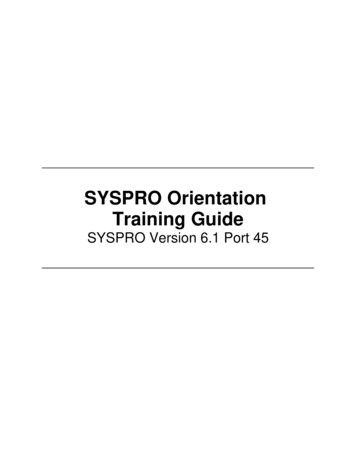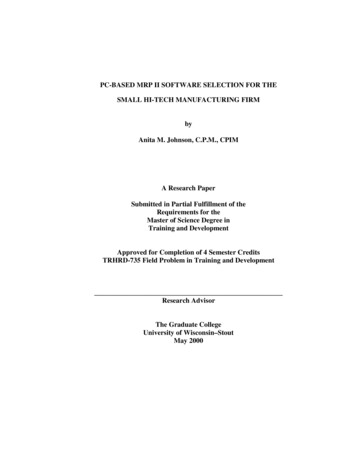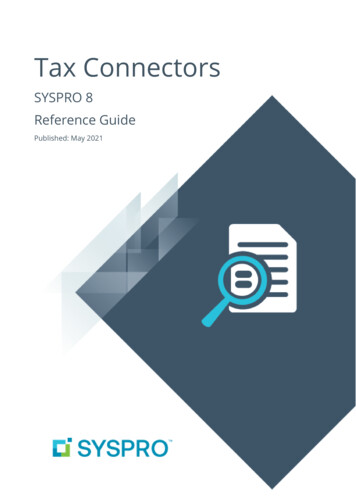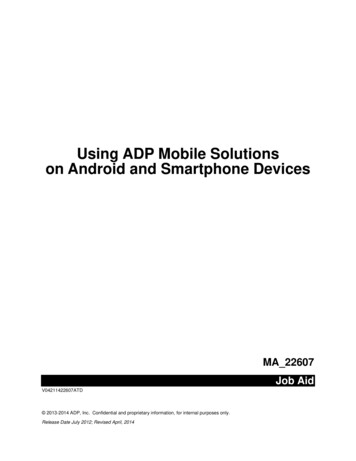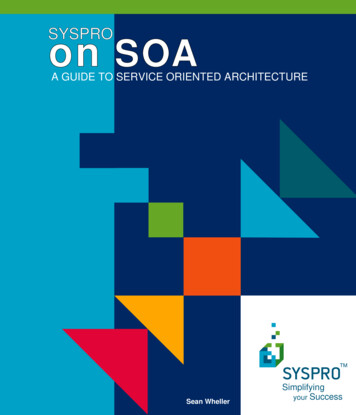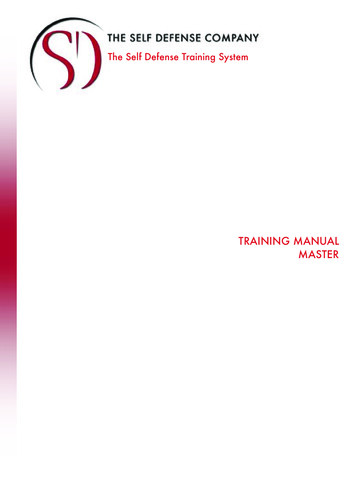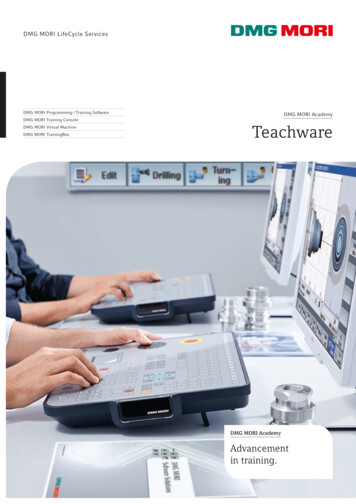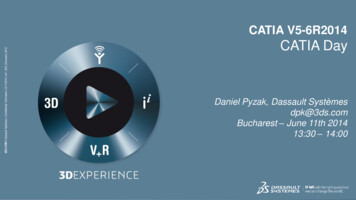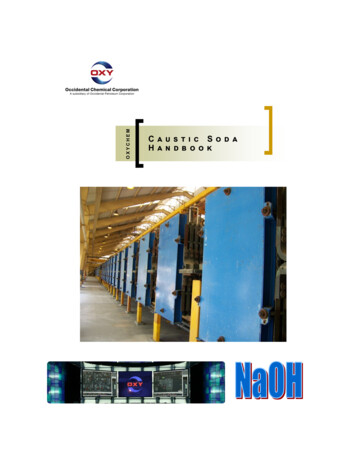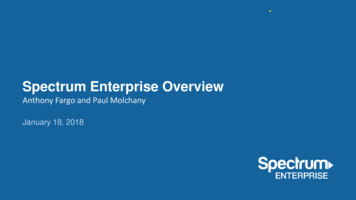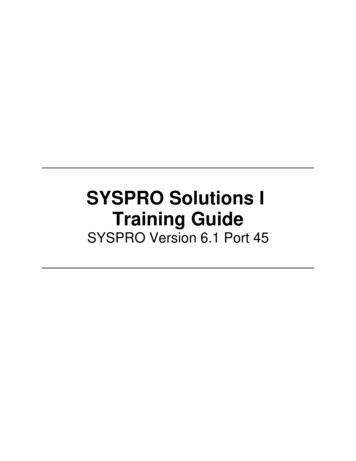
Transcription
SYSPRO Solutions ITraining GuideSYSPRO Version 6.1 Port 45
Copyright 2011 Syspro LtdPublished: 16 August 2011Revision: SYSPRO Version 6.1 Port 45All rights reserved. No part of this document may be copied, photocopied, or reproduced in any form or by any means withoutpermission in writing from Syspro Ltd. SYSPRO is a trademark of Syspro Ltd. All other trademarks, service marks, products orservices are trademarks or registered trademarks of their respective holders.Syspro Ltd reserves the right to alter the contents of this document without prior notice. While every effort is made to ensure that thecontents of this document are correct, no liability whatsoever will be accepted for any errors or omissions.This document is a copyright work and is protected by local copyright, civil and criminal law and international treaty. This documentfurther contains secret, confidential and proprietary information belonging to Syspro Ltd. It is disclosed solely for the purposes of itbeing used in the context of the licensed use of the Syspro Ltd computer software products to which it relates. Such copyright worksand information may not be published, disseminated, broadcast, copied or used for any other purpose. This document and allportions thereof included, but without limitation, copyright, trade secret and other intellectual property rights subsisting therein andrelating thereto, are and shall at all times remain the sole property of Syspro Ltd. 2011 Syspro Ltd. All rights reserved.
Table of ContentsIntroductionSYSPRO core solutions .v. vSYSPRO solutions for external integration .viSYSPRO execution and operational solutions . viiSYSPRO management and control solutions .viiSYSPRO analysis and reporting solutions . viiSYSPRO planning solutions . viiFinancialWhat is Accounts Payable? .2Process flow .2SYSPRO Accounts Payable solution . 3Integration to other solutions .3Module dependencies .4What is Accounts Receivable? . 6Process flow .6SYSPRO Accounts Receivable solution . 7Integration to other solutions .7Module dependencies .8What is Cash Book? . 10Process flow .10SYSPRO Cash Book solution . 10Integration to other solutions .11Module dependencies .11What is General Ledger? .13Process flow .14SYSPRO General Ledger solution .14Integration to other solutions .15Module dependencies .15DistributionWhat is Inventory? .18Process flow .19SYSPRO Inventory solution . 19Integration to other solutions .19Module dependencies .20What is Purchase Orders? . 22Process flow .22SYSPRO Purchase Order solution . 23Integration to other solutions .23Module dependencies .24What is Goods in Transit? . 26Process flow .26Goods in transit . 27 2011 Syspro Ltd. All rights reserved.Page i
Integration to other solutions .28Module dependencies .28What is GRN? .30Process flow .30Goods received notes (GRN) system . 31Integration to other solutions .33Module dependencies .33What is Sales Orders? .34Process flow .34SYSPRO Sales Order solution .34Integration to other solutions .35Module dependencies .36What is Sales Analysis? . 37Process flow .37SYSPRO Sales Analysis solution . 37Integration to other solutions .38Module dependencies .38ManufacturingManufacturing overview .41What is Bill of Materials? . 43Process flow .43SYSPRO Bill of Materials solution . 44Bill of Materials considerations .45Integration to other solutions .45Module dependencies .45What is Work in Progress? . 47Process flow .47SYSPRO Work in Progress solution . 48Integration to other solutions .48Module dependencies .49What is Quotations? . 51Process flow .51SYSPRO Quotations solution . 52Integration to other solutions .53Module dependencies .54What is Requirements Planning? . 55Production Planning . 55Implementation and control .55Inventory management . 56Process flow .56SYSPRO Requirements Planning solution . 57Integration to other solutions .57Module dependencies .57ConclusionConclusion .60 2011 Syspro Ltd. All rights reserved.Page ii
Related topics . 60Certification . 60Support Zone . 60Comment Sheet . 60 2011 Syspro Ltd. All rights reserved.Page iii
Introduction
SYSPRO Solutions I Training Guide: IntroductionSYSPRO core solutionsSYSPRO is a fully integrated business software solution. It assists in managing your supply chain businessprocesses, from internal planning, analysis and reporting, management and control, execution and operationalthrough to external integration.In all businesses, whether you sell or distribute products or services, add value through activities, such as packaging,or are in full-blown manufacturing, there will usually be: a procuring phase with its associated supplier sourcing; an optional design, manufacturing and packaging phase; a distribution and warehousing phase (some more complex than others); and a prospecting and selling phase.In addition, the world is moving towards more streamlined electronic communications and visibility through theWeb in all aspects of the supply chain: from lead generation, prospecting, documentation sharing on both ends of thesupply chain, customer relationship management and critical-information sharing. Interfaces with bar coding forpurchasing and job receiving, put away, material issuing, picking and packaging and stock takes.SYSPRO solutions, through standard solutions, customization and SYSPRO e.net solutions, provide all the tools anenterprise needs to manage and extend all activities of their supply chain. 2011 Syspro Ltd. All rights reserved.Page v
SYSPRO Solutions I Training Guide: IntroductionSYSPRO solutions for external integrationSYSPRO provides a number of tools that enable external applications to communicate with SYSPRO and theSYSPRO data. In addition, SYSPRO is fully integrated with Microsoft Office. Triggers and Events enable thesystem to trap any anomalies of issues that need to be actioned as and when they happen. All these tools provide foran extended enterprise and communication with business partners. 2011 Syspro Ltd. All rights reserved.Page vi
SYSPRO Solutions I Training Guide: IntroductionSYSPRO execution and operational solutionsThe SYSPRO solutions for execution and operational processes cover all routing aspects of the business fromprocurement and sourcing, through to design and manufacture, distribution and warehousing, and, finally, to sellingand after-sales service.SYSPRO management and control solutionsSYSPRO management solutions create the foundation for more successful supply chain management. Thesesolutions optimize insight into the enterprise, enabling you to reduce operational and supply chain costs, enhancedecision-making and respond more quickly to customers and the economic climate.These solutions enable growing companies to maximize the planning and management of business processes tobetter position themselves in their respective markets.SYSPRO analysis and reporting solutionsSYSPRO's Enterprise Reporting solutions close the widening gap between the volume of data and the organization'sability to use it effectively. From the SYSPRO Analytics business decision tool through to standard and customizedreports, boardroom quality reporting and executive dashboards, SYSPRO has all the building blocks required toproduce simple to sophisticated Enterprise Reporting and Queries.SYSPRO planning solutionsThese SYSPRO solutions include the functionality to handle the more complex facets of planning within yourorganization. The solutions within this sphere cover the full breadth of all planning from the factory floor to theexecutive boardroom. 2011 Syspro Ltd. All rights reserved.Page vii
SYSPRO Solutions I Training Guide: Introduction 2011 Syspro Ltd. All rights reserved.Page viii
FinancialChapter1
SYSPRO Solutions I Training Guide: Chapter 1 - FinancialWhat is Accounts Payable?A business requires a means of recording invoices and then processing the payment of monies owed to suppliers forvalid, authorized goods and services received at the appropriate time, and to reflect the entries correctly in theGeneral Ledger.Businesses need to purchase goods and services to meet the needs of their sales initiatives. For example, goods forresale or materials for production purposes need to be acquired. Businesses also need to keep track of the value ofthese goods and services acquired to pay for these charges and to determine charges for which payment has not yetbeen made. At a glance, financial executives can see what a company needs to pay, when this commitment is dueand what settlement discounts would apply if paid early. Clerks can match supplier invoices to prices quoted to thebuyers of the organization as well as what stores say the organization has received (i.e. you only pay for what youreceived at the price quoted to the buyer).Charges need to be allocated correctly to an appropriate expense or asset account in the General Ledger. Paymentsneed to be recorded in the General Ledger and at any point in time the General Ledger needs to reflect the totalmonies owing for all supplier invoices not yet paid, as reflected in the Accounts Payable ledger.Process flowStaff create requests to purchase goods to meet a customer demand or service. Requisitions may also be raised forgoods and or services required for internal purposes (e.g. stationery, consulting services, etc.). Once theserequisitions are approved then the buyers create purchase orders and a copy is given to the supplier and the stores fortheir records. Suppliers deliver the goods to the relevant warehouse. The stores personnel check the goods andquantities back to the original purchase order. The goods can be inspected and once accepted, receipted into stores.The suppliers then create an invoice based on their delivery note and your acceptance of their goods. This invoice isposted to the company and input in the Payables system and matched back to the relevant Goods Received Notereceived from stores. This invoice is then sent to the buyer for approval and thereafter it is paid according to thecompany's cash flow position and the invoice terms which have been defined.The processes with the dotted borders are not performed in this training guide. They will be covered in detail in thePurchase Order Training Guide and the Goods Received Notes Training Guide. However, the flow does give you anoverall picture of the complete process. Refer to the Require; Procure; Pay Business Process Training Guide foradditional information. 2011 Syspro Ltd. All rights reserved.Page 2
SYSPRO Solutions I Training Guide: Chapter 1 - FinancialSYSPRO Accounts Payable solutionThe Accounts Payable system provides an efficient method for recording purchases and supplier invoices as well asmaking expense distributions. It can be installed standalone or integrated with other modules in the SYSPROsystem.Included are facilities for maintaining, verifying and reporting supplier account information. The module offersoptional two-step invoice entry that allows users to enter, approve and then pay an invoice. Extensive audit trails andjournals form an integral part of the module.Against each supplier, invoice and transaction details are retained from which cash requirements, forecasting andpurchase analysis may be printed. Suppliers can be held in local or foreign currency and multi-branch accounting isavailable. In addition, free-format checks and remittances can be designed.Integration to other solutionsThe Accounts Payable solution can be run standalone or it can be integrated to other solutions. These include: Accounts ReceivableLinking of Suppliers to Customers. Cash Book 2011 Syspro Ltd. All rights reserved.Page 3
SYSPRO Solutions I Training Guide: Chapter 1 - Financial Integrating Accounts Payable payments to Cash Book for bank reconciliation purposes.Electronic Funds TransferPaying suppliers using electronic fund transfers (EFTs) which replaces the issuing of checks.Contact ManagementSupplier details are shown and can be edited from within Contact Management.Work in ProgressOption to expense invoice details directly to job issues.Landed Cost TrackingAbility to register invoices in Accounts Payable in order to update costs around shipping of orders so thatinventory controllers can receipt overseas orders into stock with actual costs. The expense disbursed is notshown against the supplier until the invoice is approved.Purchase OrdersOption to select GRN matching which allows you to match supplier invoice values to a GRN.General LedgerExpenses and disbursed amounts update different accounts in the General Ledger.Module dependenciesEssential NoneRecommended Cash Book General Ledger 2011 Syspro Ltd. All rights reserved.Page 4
SYSPRO Solutions I Training Guide: Chapter 1 - Financial 2011 Syspro Ltd. All rights reserved.Page 5
SYSPRO Solutions I Training Guide: Chapter 1 - FinancialWhat is Accounts Receivable?Most companies are in business to sell goods and/or services in order to make a profit. To achieve this, organizationsneed to have customers. To facilitate the management of customers, records must be kept of what is purchased, whatis the value of outstanding invoices and the age of these invoices. Executives need to see what money is owing tothe organization and when this money is due. Payments received from customers must be matched to the invoices inorder to keep track of unpaid invoices.As customers are at the heart of the business, it is important to keep track of the prices offered to customers forgoods and services. The discount/price matrix is maintained at customer level and this provides organizations withthe required flexibility when managing prices with customers. The matrix is used to automatically select the correctprice at time of invoicing.In some instances, customers have branches all over the country. Their requirement is to have goods delivereddirectly to their branches and invoices must be generated per branch. Payments are made centrally (i.e. the statementmust go to head office, reflecting the purchases from each branch).The Accounts Receivable system provides an efficient method for recording sales and customer payments.Integration to the General Ledger is flexible and the level of integration depends on the business requirements.Included are facilities for maintaining, verifying and reporting customer account information.Audit trails and journals are extensive and form an integral part of the module.For each customer, both invoice and transaction details are retained from which cash forecasting and sales analysiscan be obtained. Customers can be held in local or foreign currency and multi-branch accounting is available.Additionally, free-format statements can be designed.In summary a business needs a means to record all sales and payments received from its customers. In order toidentify future sales opportunities, a record must be kept of what customers are purchasing and when.Process flowThe decision is made as to which suppliers will be paid electronically. These can be permanent or temporarysuppliers. The bank from which the funds are being transferred is defined as an Electronic Fund Transfer bank andthe supplier is defined as being Electronic Fund Transfer supplier. When performing a payment run, from either theAccounts Payable module or the Cash Book module, these suppliers will be paid electronically. In SYSPRO thesuppliers need to be added as beneficiaries in the Cash Book.Once the payments have been approved an extract XML file is created which can then be transformed into therelevant format that the bank needs and sent to them for payment. SYSPRO will create the XML file but not the filethat is needed for all the different banks because each bank has a different format. You need to get a 3rd partydeveloper to create the special bank files. 2011 Syspro Ltd. All rights reserved.Page 6
SYSPRO Solutions I Training Guide: Chapter 1 - FinancialSYSPRO Accounts Receivable solutionThe Accounts Receivable system provides users with extensive control of customer information. Analysis andreporting can be performed on an open-item or balance-forward basis using various ageing options. Information fora defined series of related customers may be accumulated into a single master account for consolidated statementprinting. In addition, free-format statements and recurring invoices can be designed.Receivables can be held in a local or foreign currency and the system complies with European Monetary Union (EMU) requirements. Extensive cash posting facilities exist, which include post dated check entry and posting,miscellaneous unassigned cash receipts and the facility to post cash received to invoices manually or automaticallyby invoice or aged date.Integration to other solutionsThe Accounts Receivable solution can be run standalone or it can be integrated to other solutions. These solutionsinclude: Accounts PayableLinking of customers to suppliers. Cash BookIntegration of invoice payment receipts and miscellaneous cash receipts. Contact ManagementCustomer details are shown and can be edited in Contact Management and CMS Accounts can be convertedinto customers. General LedgerIntegration of sales and cost of sales information.Integration of cash receipts (payments). Sales AnalysisAccounts Receivable information is available on the following Sales Analysis reports: Sales by salesperson, product class, and customer Sales commissions Sales tax schedules 2011 Syspro Ltd. All rights reserved.Page 7
SYSPRO Solutions I Training Guide: Chapter 1 - Financial Turnover reports Sales OrdersThe following Sales Order information is transferred to Accounts Receivable: Sales and cost-of-sales-related distributions Sales Order processes that update stock quantities: Order Entry (allocations) Invoice printing Credit invoice printing (returns to inventory) Debit invoice printing (issues) Document print capability: Invoices/debit notes/credit notes Delivery notes and order acknowledgments Customer information, if required, can be passed to the following modules: Purchase Orders Blanket Sales Orders Counter Sales Return Merchandise Quotations Work in ProgressModule dependenciesEssential NoneRecommended Cash Book General Ledger Sales Orders (especially if you wish to print delivery notes, invoices, debit and credit notes) 2011 Syspro Ltd. All rights reserved.Page 8
SYSPRO Solutions I Training Guide: Chapter 1 - Financial 2011 Syspro Ltd. All rights reserved.Page 9
SYSPRO Solutions I Training Guide: Chapter 1 - FinancialWhat is Cash Book?'Cash, being the most liquid form of money, is of prime importance to the enterprise. Cash must be carefullyadministered and controlled, and the cash flow recorded in the cash journal. The balance on the cash account mustregularly be reconciled with the bank balance'. (Accounting An Introduction, Faul, Pistorius, Van Vuuren).Most businesses are in business to sell goods and/or services in order to make a profit. In order to do this,organizations need to have customers and suppliers. To facilitate the management of cash inflow and outflow, anorganization requires a Cash Book in which to record all cash transactions.As cash flow is a crucial aspect in any business, it is important to accurately record all receipts and payments andkeep a record of the transactions that have been processed by the bank (bank reconciliation). You would use a CashBook to collect all the cash transactions (payments and receipts) and ensure the effective documentation of all cashtransactions.Process flowThe Cash Book solution provides an efficient way of recording all withdrawals and payments that are made byorganizations. All payments made to suppliers (including electronic payments) and receipts from customers areautomatically posted to the Cash Book as well as sundry payments and receipts.Repetitive payments (e.g. automatic payments for insurance premiums) can be set up to post automatically to theCash Book on the day that they are due to go through the bank.If required, the bank statement can be downloaded into the system and the converted file can be used toautomatically reconcil
SYSPRO core solutions SYSPRO is a fully integrated business software solution. It assists in managing your supply chain business processes, from internal planning, analysis and rep
